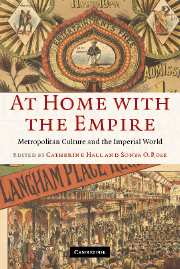Book contents
- Frontmatter
- Contents
- Notes on contributors
- 1 Introduction: being at home with the Empire
- 2 At home with history Macaulay and the History of England
- 3 A homogeneous society? Britain's internal ‘others’, 1800–present
- 4 At home with the Empire: the example of Ireland
- 5 The condition of women, women's writing and the Empire in nineteenth-century Britain
- 6 Sexuality and empire
- 7 Religion and empire at home
- 8 Metropolitan desires and colonial connections: reflections on consumption and empire
- 9 Imagining empire: history, fantasy and literature
- 10 New narratives of imperial politics in the nineteenth century
- 11 Bringing the Empire home: women activists in imperial Britain, 1790s–1930s
- 12 Taking class notes on empire
- 13 Citizenship and empire, 1867–1928
- Select bibliography
- Index
7 - Religion and empire at home
Published online by Cambridge University Press: 11 April 2011
- Frontmatter
- Contents
- Notes on contributors
- 1 Introduction: being at home with the Empire
- 2 At home with history Macaulay and the History of England
- 3 A homogeneous society? Britain's internal ‘others’, 1800–present
- 4 At home with the Empire: the example of Ireland
- 5 The condition of women, women's writing and the Empire in nineteenth-century Britain
- 6 Sexuality and empire
- 7 Religion and empire at home
- 8 Metropolitan desires and colonial connections: reflections on consumption and empire
- 9 Imagining empire: history, fantasy and literature
- 10 New narratives of imperial politics in the nineteenth century
- 11 Bringing the Empire home: women activists in imperial Britain, 1790s–1930s
- 12 Taking class notes on empire
- 13 Citizenship and empire, 1867–1928
- Select bibliography
- Index
Summary
Organised religion was one of the most powerful sources of inspiration and sites of association in Victorian Britain. Few historians who work on the nineteenth century today would object to G. Kitson Clark's revisionist insistence in 1962 that ‘in no other century, except the seventeenth and perhaps the twelfth, did the claims of religion occupy so large a part of the nation's life, or did men speaking in the name of religion contrive to exercise so much power’. While contemporaries were alarmed that ‘only’ half of Britain's adult population attended church or chapel services on a regular basis, this far exceeded the social catchments of all other institutions in Victorian political culture. Moreover, most of the adults who were not regular churchgoers had probably been exposed to organised religion as children. Virtually every working-class child attended Britain's massively popular Sunday Schools at one point or another.
Victorian religious practice was, furthermore, a very public and political praxis. In fact, Victorian public opinion was ‘educated from the pulpit’. This does not mean that religious Victorians spoke with a unified political voice. To the contrary, theological and sectarian differences were among the most important fault lines informing the nation's party political divide. While Nonconformists were nearly unanimous in their support for the Liberal Party, at least before 1886, Anglicans were as ardent if not quite as unified in their support for the Conservative Party.
- Type
- Chapter
- Information
- At Home with the EmpireMetropolitan Culture and the Imperial World, pp. 143 - 165Publisher: Cambridge University PressPrint publication year: 2006
- 6
- Cited by



